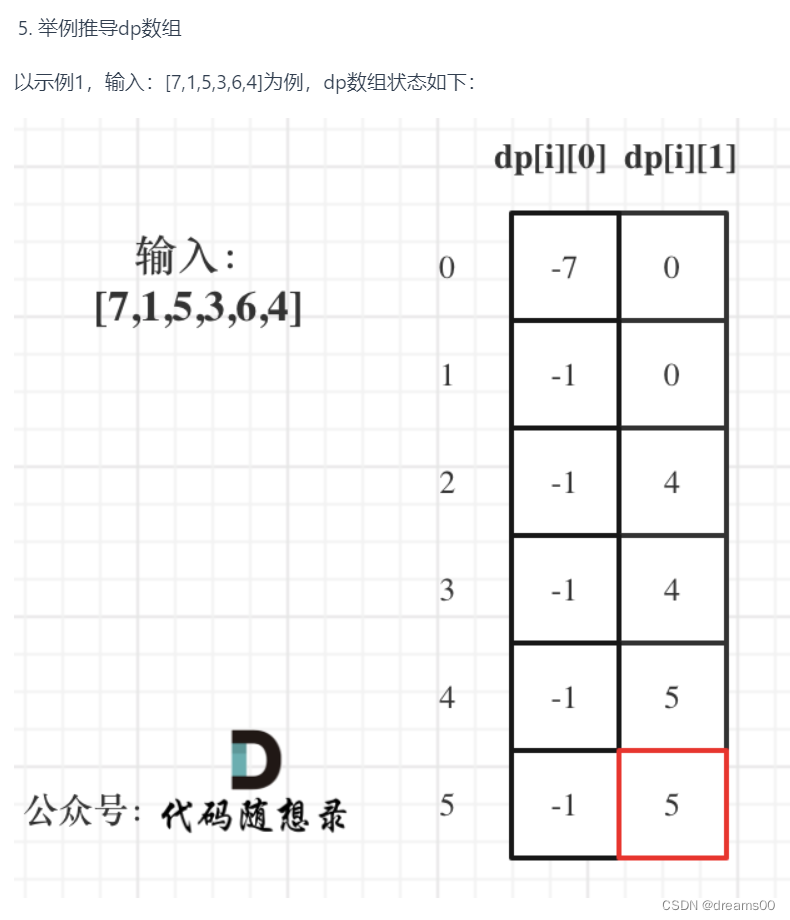-
代码随想录算法训练营第49天|121. 买卖股票的最佳时机,买卖股票的最佳时机II
链接: 121. 买卖股票的最佳时机
链接: 122.买卖股票的最佳时机II121. 买卖股票的最佳时机
给定一个数组 prices ,它的第 i 个元素 prices[i] 表示一支给定股票第 i 天的价格。
你只能选择 某一天 买入这只股票,并选择在 未来的某一个不同的日子 卖出该股票。设计一个算法来计算你所能获取的最大利润。
返回你可以从这笔交易中获取的最大利润。如果你不能获取任何利润,返回 0 。
示例 1:
输入:[7,1,5,3,6,4]
输出:5
解释:在第 2 天(股票价格 = 1)的时候买入,在第 5 天(股票价格 = 6)的时候卖出,最大利润 = 6-1 = 5 。
注意利润不能是 7-1 = 6, 因为卖出价格需要大于买入价格;同时,你不能在买入前卖出股票。
示例 2:输入:prices = [7,6,4,3,1]
输出:0
解释:在这种情况下, 没有交易完成, 所以最大利润为 0。这道题得解题关键时,需要一个二维数组用两列来表示不同状态下(持有,不持有),每天所获得最大利润。

class Solution { public int maxProfit(int[] prices) { int[][] dp = new int[prices.length][2]; /** dp[i][0] 表示第i天持有该股票所获得最大利润 dp[i][1] 表示第i天不持有该股票所获得最大利润 */ dp[0][0] = -prices[0]; dp[0][1] = 0; for(int i = 1; i < prices.length; i++){ dp[i][0] = Math.max(dp[i-1][0], -prices[i]); dp[i][1] = Math.max(dp[i-1][1], dp[i-1][0] + prices[i]); } return dp[prices.length - 1][1]; } }- 1
- 2
- 3
- 4
- 5
- 6
- 7
- 8
- 9
- 10
- 11
- 12
- 13
- 14
- 15
- 16
- 17
- 18
买卖股票的最佳时机II
这里重申一下dp数组的含义:
- dp[i][0] 表示第i天持有股票所得现金。
- dp[i][1] 表示第i天不持有股票所得最多现金
如果第i天持有股票即dp[i][0],那么可以由两个状态推出来
- 第i-1天就持有股票,那么就保持现状,所得现金就是昨天持有股票的所得现金 即:dp[i - 1][0]
- 第i天买入股票,所得现金就是昨天不持有股票的所得现金减去 今天的股票价格 即:dp[i - 1][1] - prices[i]
在121. 买卖股票的最佳时机 (opens new window)中,因为股票全程只能买卖一次,所以如果买入股票,那么第i天持有股票即dp[i][0]一定就是 -prices[i]。
而本题,因为一只股票可以买卖多次,所以当第i天买入股票的时候,所持有的现金可能有之前买卖过的利润。
那么第i天持有股票即dp[i][0],如果是第i天买入股票,所得现金就是昨天不持有股票的所得现金 减去 今天的股票价格 即:dp[i - 1][1] - prices[i]。
class Solution { public int maxProfit(int[] prices) { int len = prices.length; int[][] dp = new int[len][2]; dp[0][0] = -prices[0]; dp[0][1] = 0; for(int i = 1; i < prices.length; i++){ dp[i][0] = Math.max(dp[i-1][0], dp[i-1][1] - prices[i]); dp[i][1] = Math.max(dp[i-1][1], dp[i-1][0] + prices[i]); } return dp[len-1][1]; } }- 1
- 2
- 3
- 4
- 5
- 6
- 7
- 8
- 9
- 10
- 11
- 12
- 13
- 14
- 15
- 16
-
相关阅读:
【AIGC调研系列】Gitlab的Duo Chat与其他辅助编程助手相比的优缺点
【Python共享文件】——Python快速搭建HTTP web服务实现文件共享并公网远程访问
高数笔记03:几何、物理应用
计算机毕业设计Java编程训练系统设计与实现(源码+系统+mysql数据库+lw文档)
mysql主从搭建详细步骤
生产实用Shell脚本合集
SRT参数说明
Spring 面试题
十一、任务调度算法
电子信息工程专业课复习知识点总结:(三)数电
- 原文地址:https://blog.csdn.net/dreams00/article/details/132899492
